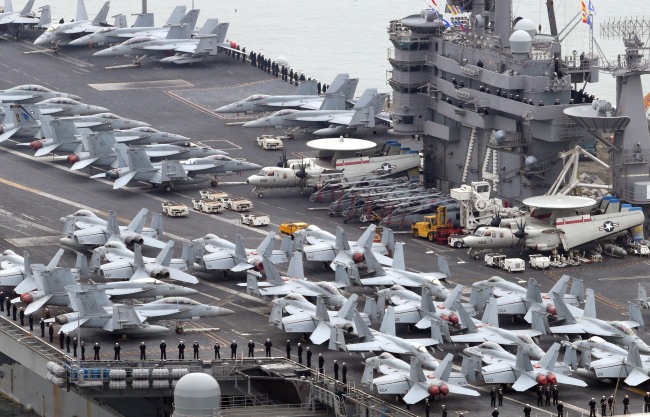BUSAN — A U.S. nuclear-powered supercarrier John C. Stennis arrived in South Korea on Sunday to participate in the allies’ joint military exercise this month, amid rising inter-Korea tensions sparked by repeated provocations from North Korea.
The USS John C. Stennis strike group, led by Rear Admiral Ronald Boxall, docked in Busan harbor in the morning. The fleet had sailed through the South China seas en route to Busan, possibly sending a message toward China.
Rear Admiral Bill Byrne, the commander of U.S. Naval Forces Korea said that their presence is to prevent further provocations from the communist state.
 |
| Yonhap |
This year’s March 7-18 Key Resolve exercise marks the largest of its kind as the allies strengthen their defense cooperation against North Korea’s increasing nuclear and missile threats. North Korea conducted its fourth nuclear test on Jan. 6 and a long-range rocket test on Feb. 7.
Pyongyang on Thursday launched short-range ballistic missiles into the East Sea and declared to nullify all inter-Korea projects.
“The presence of John C. Stennis and the John C. Stennis strike group is to deter such provocations,” he said in a press conference.
“The missile launches (on Thursday) were clear violations of the U.N. Security Council resolutions. The U.S., the R.O.K. (South Korea) and other peaceful nations are trying to get North Korea to not commit such provocative actions. Our focus is on deterrence.”
He reiterated that the ship’s presence is part of a routine practice that has been preplanned for months, and is not in reaction to the North’s recent actions. The officials also denied that its presence in Chinese waters was a signal aimed at the U.S.’ powerful rival.
The 103,000-ton aircraft carrier will lead the 7,000-strong USS John C. Stennis Strike Group.
A total of 72 aircrafts are onboard the vessel, mainly F-18 “Super Hornet” fighter jets, along with E-2C Hawkeye early-warning aircraft, EA-6B Prowler combat jets, and HS-16 “Nighthawk” helicopters for search and rescue.
According to a U.S. navy official, it marks the first time in the past 10 years that a U.S. aircraft came to South Korea.
Adm. Boxall said that the arrival of the John C. Stennis Strike Group illustrates the U.S. navy’s “ironclad commitment” to Seoul-Washington alliance.
Three other guided-missile destroyers — the USS Stockdale, USS Chung-Hoon and USS William P. Lawrence — will join the Busan port visit, along with the USS Mobile Bay cruiser.
The USS John C. Stennis is the U.S. Navy’s seventh Nimitz-class, nuclear-powered supercarrier, loaded with navy and marine aircraft, including the F-18 Hornet and EA-6B Prowler combat jets as well as the E-2C Hawkeye early-warning aircraft.
The aircraft carrier’s two nuclear reactors provide almost unlimited range of operation and a maximum speed of some 56 kilometers per hour.
Deployment of the USS John C. Stennis is considered Washington’s stern message to Pyongyang. On Jan. 10, four days after the nuclear test, the United States deployed strategic bomber B-52 to South Korea. Following the missile test in February, the nuclear-propelled USS North Carolina attack submarine visited Busan. F-22 stealth bombers also landed in South Korea last month.
The United States is reportedly considering mobilizing its B-2 stealth bomber during the exercise.
The same day, Pyongyang continued to tout its nuclear attack capability, claiming its hydrogen bomb placed on top of an intercontinental ballistic missile can wipe out everyone in Manhattan, according to North Korea’s state-run propaganda outlet.
Citing an article by a nuclear scientist, DPRK Today claimed that the North has succeeded in miniaturizing nuclear warheads and making the delivery systems more precise. The scientist said the North is capable of making a bomb or warhead with a yield of some 15 kilotons.
It argued that the hydrogen bomb that the country has developed is more powerful than those made by the former Soviet Union.
The country has maintained that the fourth nuclear test conducted on Jan. 6 involved a hydrogen device, which is usually more powerful than a conventional nuclear bomb. Outside experts have cast doubts on the hydrogen bomb claim, citing its relatively low yield.
The article then said that the miniaturization of nuclear weapons is a meaningful development in economic terms.
It said if the country was able to make just one bomb with 50 kilograms of enriched uranium or plutonium, it could now make one with just 5 kilograms.
The scientist, moreover, stressed that the North will continue to upgrade its nuclear capability so it can overpower all its enemies.
The latest announcement by the isolated country comes after it was slapped with the toughest sanctions yet by the United Nations Security Council earlier this month for testing its fourth nuclear device and launching a long range missile.
It also shot off a short-range multiple launch rocket system and a pair of ballistic missiles as the joint Key Resolve and Foal Eagle exercise kicked off in South Korea.
The North has maintained for some time that it has the capability to miniaturize nuclear warheads so they can fit onto a ballistic missile, but such claims are contested by outside sources.
Related to the latest claim, the same outlets said in a separate piece citing a military officer that the “miniaturized” nuclear warhead that North Korea said could be placed on a ballistic missile last week is not a mockup.
The government mouthpiece said the spherical warhead shown in a picture last Wednesday is a real warhead that the rest of the world does not know about.
It argued that the warhead represents the latest high-tech military hardware and is not something that has been made up, as claimed by detractors.
By Yoon Min-sik and news reports

